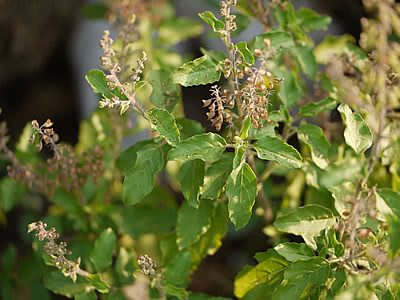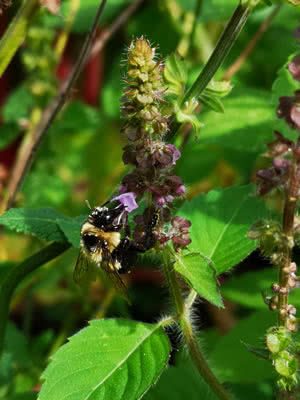Holy Basil Tulsi, or just Tulsi, is an upright subshrub with highly aromatic leaves, known for its religious, medicinal, cosmetic, and culinary uses. It is native to the Indian subcontinent and extensively cultivated in South Asia. In appearance, Tulsi bears a strong resemblance to common basil (Ocimum basilicum). It features erect, branching, densely hairy stems that lignify from the base. Its leaves are elliptical to oval, green or purplish, simple, petiolated, soft, with serrated margins, arranged in a decussate pattern, and highly aromatic. Purple flowers appear in whorls along elongated terminal inflorescences, in a raceme arrangement. Numerous varieties of this species exist, including Krishna Tulsi, Vishnu Tulsi, Rama Tulsi, Vana Tulsi (wild), Shyama Tulsi, and Thai Tulsi (used in Thai cuisine).

Holy Basil Tulsi has been used for thousands of years in India’s traditional medicines: Ayurveda and Siddha. It is rich in essential oils and active compounds like oleanolic acid, ursolic acid, rosmarinic acid, eugenol, carvacrol, linalool, β-caryophyllene, β-elemene, and germacrene. Widely brewed into herbal infusions, it boasts a sweet, distinctive, and pungent aroma. It’s an integral part of Vaishnavism within Hinduism, where devotees engage in worship involving holy basil leaves.
For Hindus, each part of the Tulsi plant is revered and considered sacred, even the soil around it. It holds a strong connection to the deity Vishnu and his avatars, used in offering and worship ceremonies. Traditionally, Tulsi is planted in the center of Hindu households’ courtyards, as well as around temples. Just as respecting Holy Basil is rewarding, disrespect can incur Vishnu’s wrath. Cutting or plucking its branches is prohibited, as is throwing dirty water near it. Although fresh leaves are essential for Hindu worship, rules govern this practice, including a prayer of forgiveness.
It thrives in full sun or partial shade, in fertile, well-draining soil enriched with organic matter, and requires regular watering. Unlike common basil, its durability is greater, and its aroma remains unaffected by flowering. Cultivate Tulsi in your garden and relish aromatic infusions, create incense from its branches, and observe bees and butterflies flocking to its flowers. It prefers mild to warm temperatures and is sensitive to severe cold or frost. In temperate regions, bring it indoors during winter near a sunny window to fill your rooms with its refreshing fragrance. Propagate through cuttings and seeds, which only germinate in the presence of light. Sow the seeds in moist substrate after the last frost in spring. Germination takes approximately three weeks.


